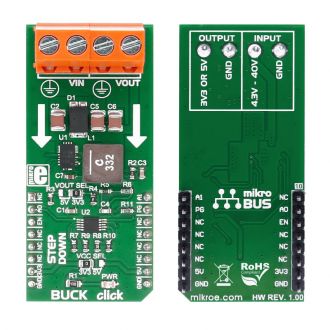
We strongly encourage users to use Package manager for sharing their code on Libstock website, because it boosts your efficiency and leaves the end user with no room for error. [more info]

Rating:
Author: MIKROE
Last Updated: 2019-01-14
Package Version: 1.0.0.2
mikroSDK Library: 1.0.0.0
Category: Buck
Downloaded: 5383 times
Not followed.
License: MIT license
BUCK click is a buck switching regulator that accepts a wide input voltage range of up to 40V and steps it down to 3.3V or 5V. The click carries the LT3976 40V, 5A, 2MHz step-down switching regulator with 3.3µA quiescent current.
Do you want to subscribe in order to receive notifications regarding "Buck click" changes.
Do you want to unsubscribe in order to stop receiving notifications regarding "Buck click" changes.
Do you want to report abuse regarding "Buck click".

Library Description
The library covers all the necessary functions to control Buck Click board. Buck click communicates with the target microcontroller over the following pins on the mikroBUS™ line: PWM, INT, RS, CS. This library contains drivers for soft reset, for enabling and disabling, for checking state of internal comparator, for setting A1 and A2 multiplexer and for setting the switching frequency function of LT3976 chip on Buck Click.
Key functions:
void buck_softReset() -Soft reset chip function.void buck_enable() - Enable switch channel function.void buck_switchFreq( uint8_t frequency ) - Switch the frequency function.Examples description
The application is composed of the three sections :
void applicationTask()
{
if ( buck_getPowerGood() )
{
mikrobus_logWrite( " Power good output voltage! ", _LOG_LINE );
}
Delay_ms( 1000 );
mikrobus_logWrite( "----------------------------", _LOG_LINE );
mikrobus_logWrite( " Switching frequency 400kHz ", _LOG_LINE );
mikrobus_logWrite( "----------------------------", _LOG_LINE );
buck_switchFreq( _BUCK_FREQ_400KHz );
Delay_ms( 5000 );
mikrobus_logWrite( " Switching frequency 800kHz ", _LOG_LINE );
mikrobus_logWrite( "----------------------------", _LOG_LINE );
buck_switchFreq( _BUCK_FREQ_800KHz );
Delay_ms( 5000 );
}
Other mikroE Libraries used in the example:
Additional notes and information
Depending on the development board you are using, you may need USB UART click, USB UART 2 click or RS232 click to connect to your PC, for development systems with no UART to USB interface available on the board. The terminal available in all MikroElektronika compilers, or any other terminal application of your choice, can be used to read the message.